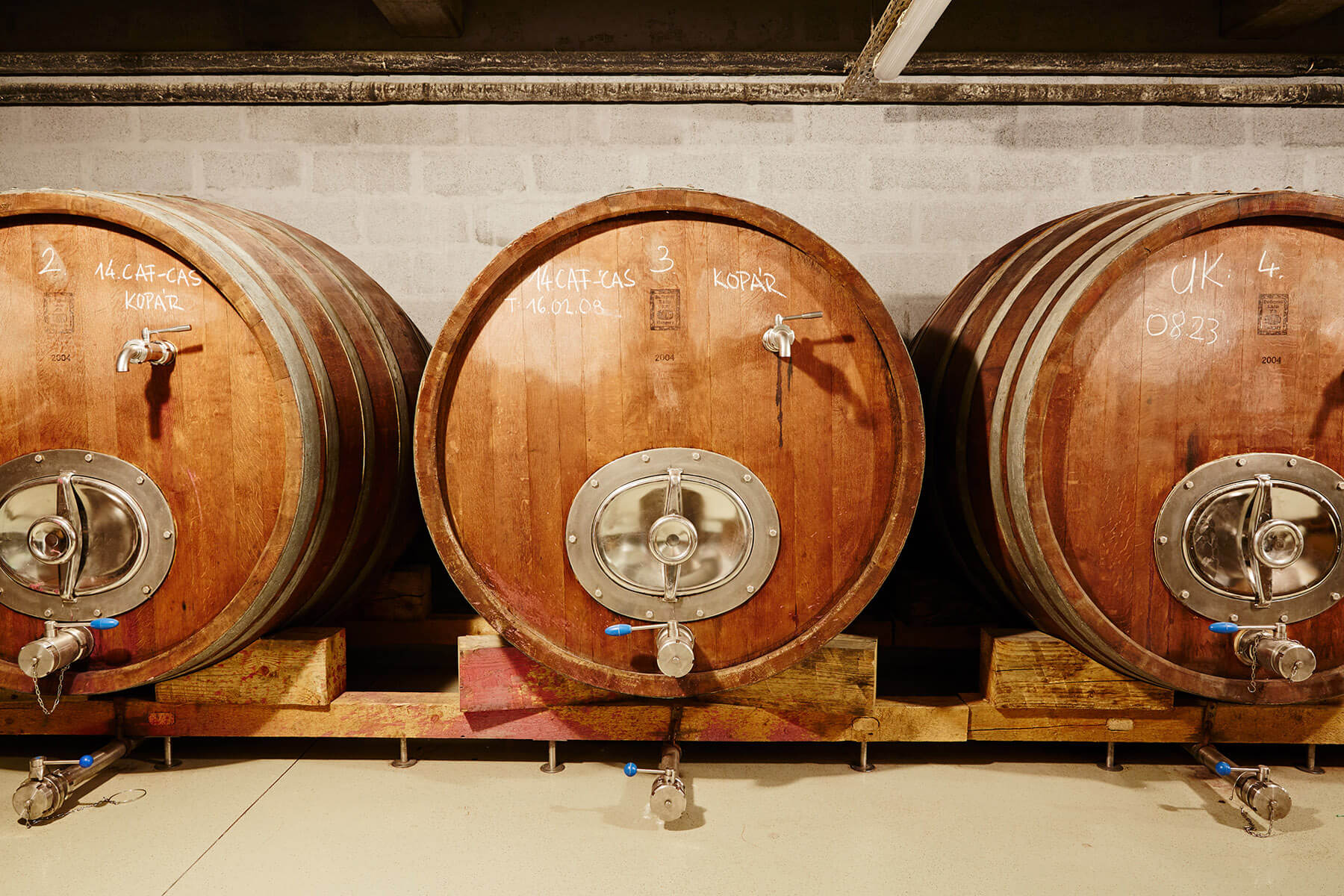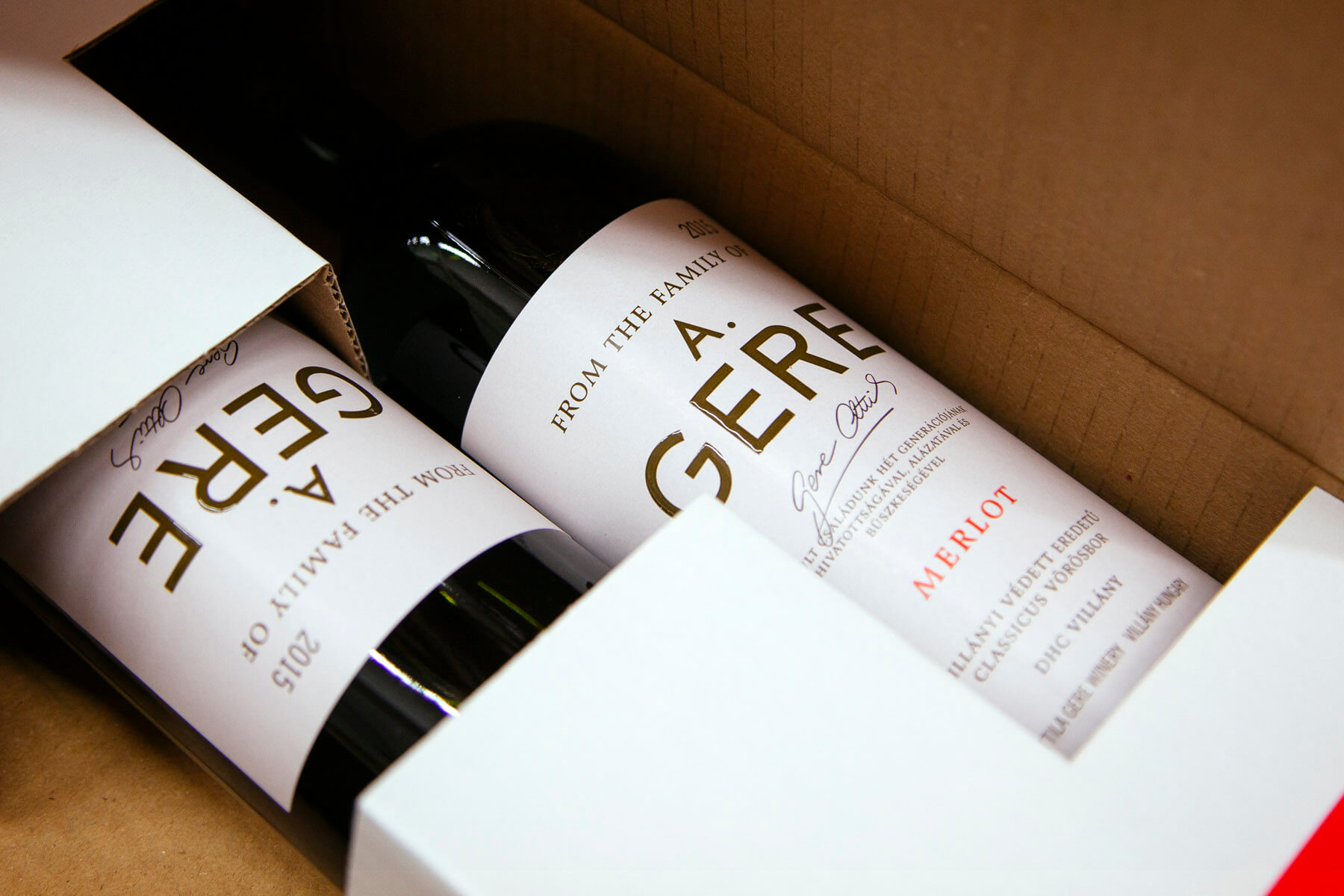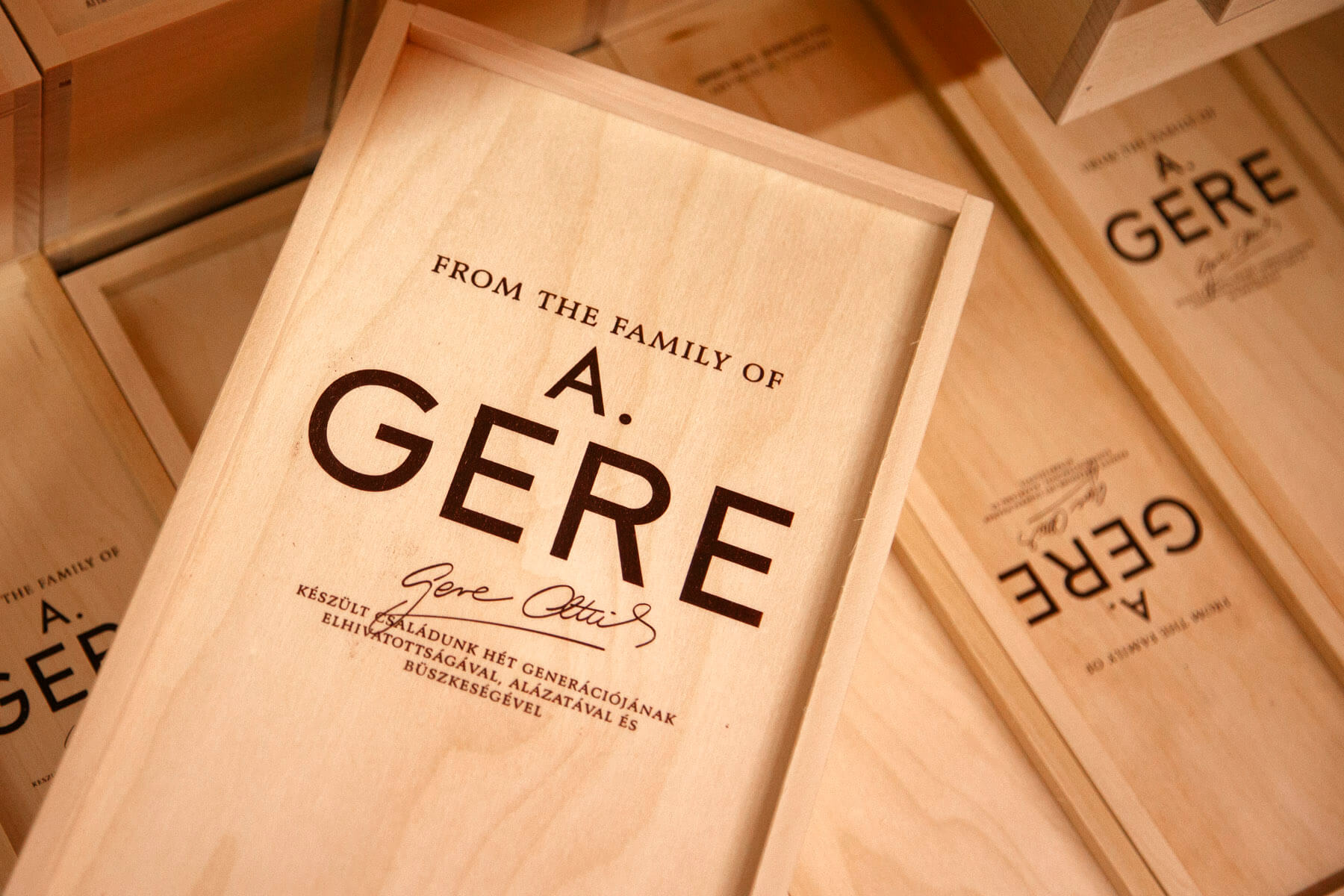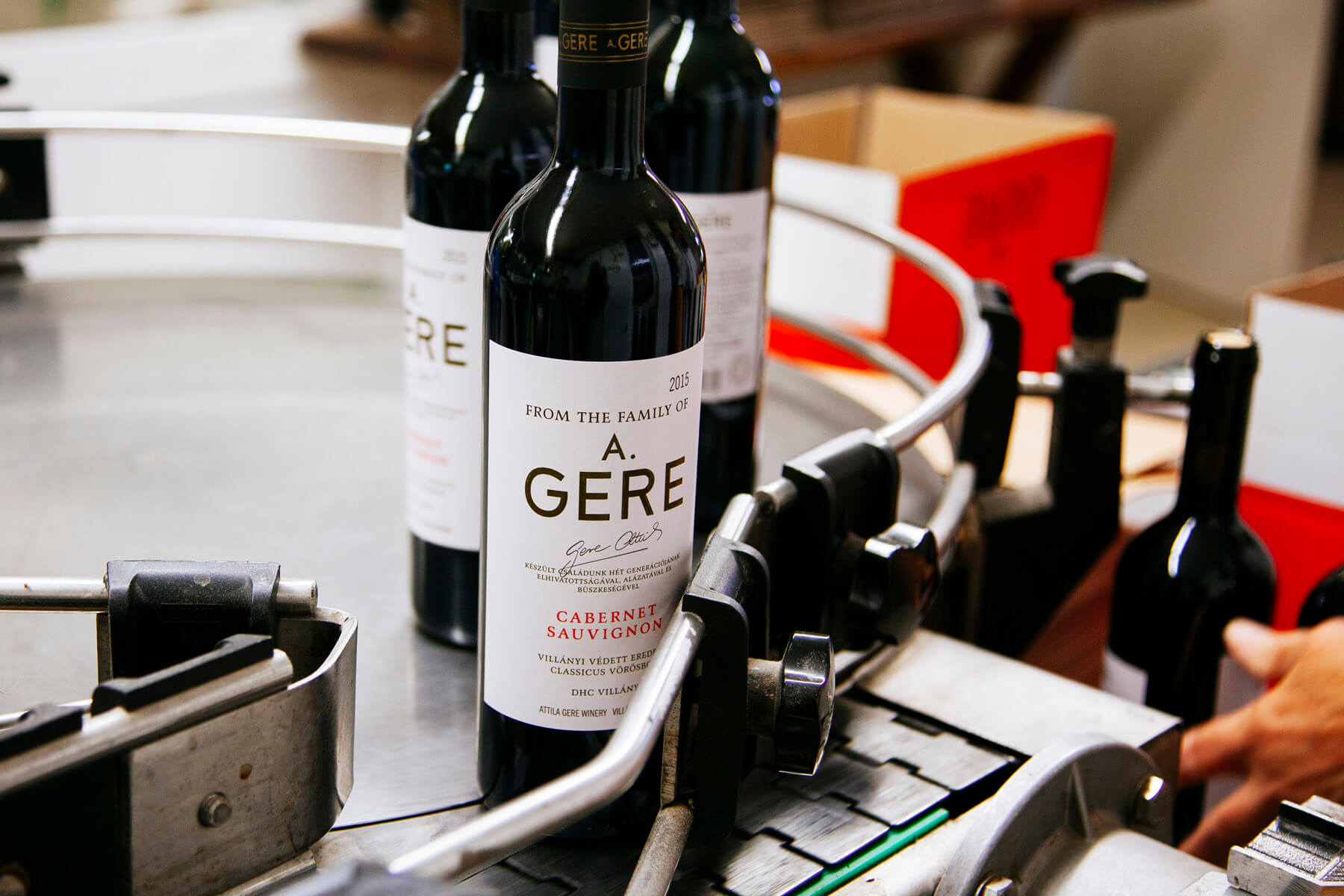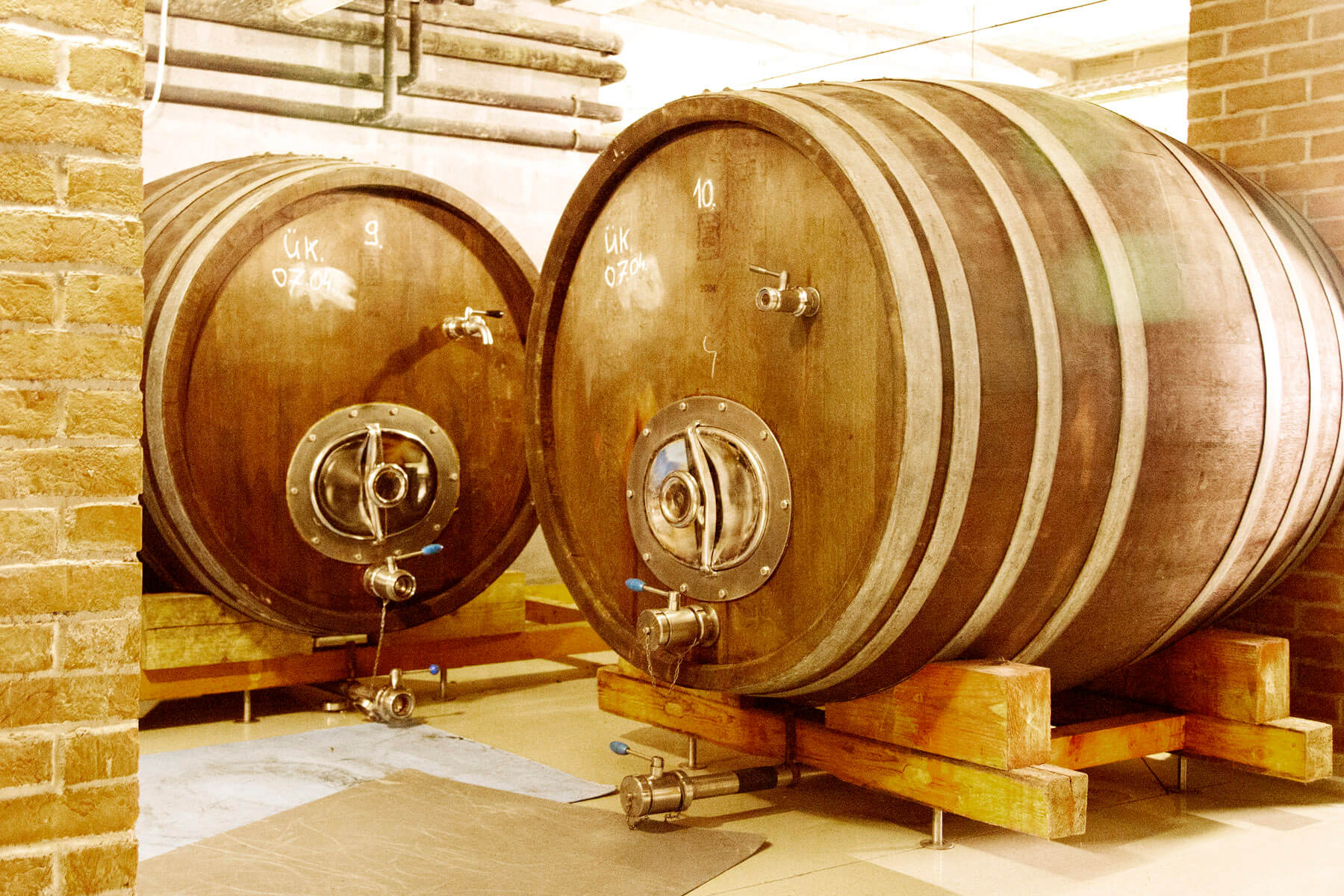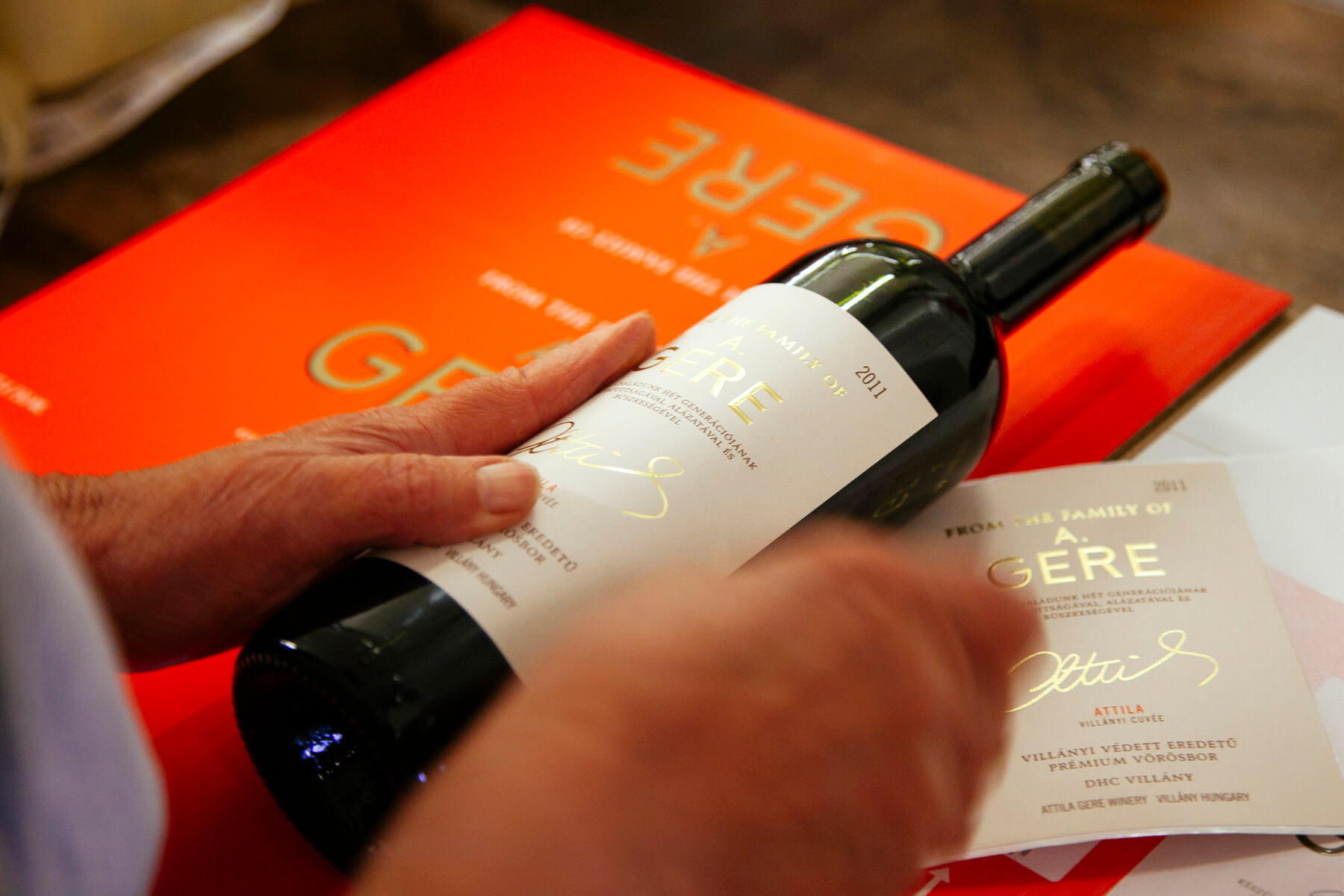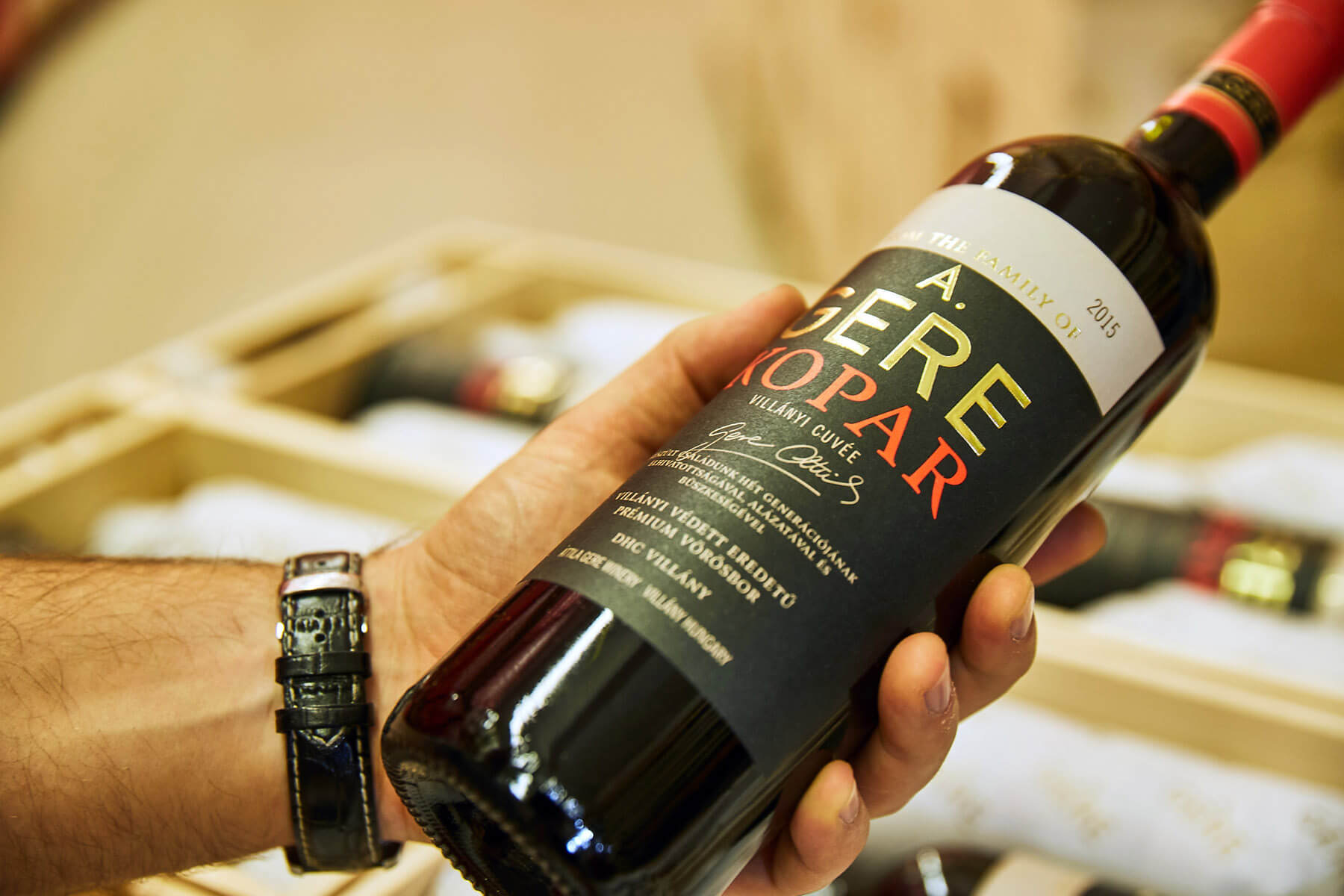Situated in the southernmost tip of Hungary the origins of viticulture in this wine region go back to Roman times. The immigration of German speaking Swabians to the region in the 18th century has brought significant changes and development both in viticulture and winemaking. This is the time when the famed rows of cellars were built in Villány. Following the Phylloxera blight the breeding programs of Count Zsigmond Teleki represent an important milestone in the history of Villány, the scheme has brought international recognition for the whole region. The production of family farms based on centuries long tradition was organized and distributed by merchants, negociants making sure that the wines of Villány would reach far away trading posts.
From the early 1990s, following the fall of communism family businesses were reestablished. Villány smallholders, including Attila Gere, joined forces and thanks to their efforts to revive old traditions the quality of their bottlings put Villány on level with the best in the world.
Today there are cca. 2500 hectares of vineyards in the hills surrounding Villány and Siklós. In and around Villány you will find more black grapes, while in the Siklós area there are more white grapes grown, but overall the wine regions is best known for its red wines.
The region’s undisputed star is the Villányi Franc. Though Cabernet Franc is grown all over the world it is mostly used as a blending partner, however bottled as a single variety it reaches its pinnacle in Villány. The unique terroir, the climate and the winemaking traditions give a distinct quality to the wines made from this variety and this is why the premium and super premium quality level Cabernet Francs of Villány are called Villányi Franc. Typically these wines are elegant, complex, rich, powerful, dynamic, spicy and well-structured with zesty acidity, velvety tannins and a great balance.
The numerous accolades won at various international wine competitions testify to the special quality the variety can reach in Villány. „Cabernet Franc has found its natural home in Villány”, wrote the world renowned expert, Michael Broadbent MW in 2000 in his column in Decanter Magazine.
VILLÁNY TERROIR
The wine region’s climate is continental, with some submediterranean influence. In terms of annual average temperature and sunshine hours it boasts the highest figures among all Hungarian wine regions, the warm and dry weather translates into relatively long vegetation period. The slopes are usually protected from several directions and the heat retained is further enhanced by the warm air coming in from the Mediterranean thus creating a rather unique submediterranean microclimate.
The soil is mainly loess and red clay on a limestone bedding. In some plots loess is mixed with Triassic dolomites, limestone and Jurassic limestone. One of the pecularities of the region is the presence of geothermal heat. On average soil temperature increases by 1 Celsius degree every 33 meters towards the Earth’s core, however in Villány you get 1 Celsius degree rise at every 10-12 meters. The whole region is rich in thermal springs and rills.
- Climate
-
The wine region’s climate is continental, with some submediterranean influence. In terms of annual average temperature and sunshine hours it boasts the highest figures among all Hungarian wine regions, the warm and dry weather translates into relatively long vegetation period. The slopes are usually protected from several directions and the heat retained is further enhanced by the warm air coming in from the Mediterranean thus creating a rather unique submediterranean microclimate.
- Soil
-
The soil is mainly loess and red clay on a limestone bedding. In some plots loess is mixed with Triassic dolomites, limestone and Jurassic limestone. One of the pecularities of the region is the presence of geothermal heat. On average soil temperature increases by 1 Celsius degree every 33 meters towards the Earth’s core, however in Villány you get 1 Celsius degree rise at every 10-12 meters. The whole region is rich in thermal springs and rills.
We have vineyards in some of the most outstanding areas of the Villány-Siklós wine region including Kopár, Konkoly, Csillagvölgy and Ördögárok. In terms of soil and climate there are subtle differencies between these plots, however they share some common characteristics like the loess topsoils rich in chalk with a limestone-dolomite bedding underneath and this makes them eminently suitable for the production of great red wines.
We knew from our grandparents’ accounts that there were some plots which were famous once due to their outstanding qualities but were abandoned and left fallow for many years. Beginning in the 1990s we gradually acquired some of these disused vineyards and replanted them.
There is no top quality wine without top quality grapes. We have an uncompromising attitude when it comes to quality, so since 2010 all vineyards belonging to the Gere Attila Family Winery are farmed organically. Our respect for the environment is reflected in the outstanding quality of the harvest: the grapes are healthy, rich in nutrients but free of chemicals.
TECHNOLOGICAL DATA
| Area under vine: | 75 ha |
| Density: | 7200 vines/ha |
| Canopy management: | two trunks – mid-wire cordon |
| Yield (for premium quality wines): | one bunch per cane; 0,7-1 kg/vine |
| Varieties grown: | Cabernet Franc, Cabernet Sauvignon, Merlot, Portugieser, Pinot Noir, Syrah, Medoc Noir, Tempranillo, Kékfrankos, Fekete Járdovány |
VINEYARDS
Widely considered as one of the best crus in Villány, Kopár (meaning ’barren’) is situated on the southern slopes of Szársomlyó Hill (442 m) between Villány and Nagyharsány. Its total area is 63,5 ha. This is the most southernly vineyard of Hungary with an altitude of 120-130 meters above sea level.
Due to its sheer extension Kopár is a multifaceted growing area. There are sections facing south-southeast, while others face south-southwest, and besides the differencies in altitude the angle of the slopes is also different: at the bottom of the hill the gradient is lower (6-13%), higher up it gets progressively steeper (21-30%). The western section of Kopár facing Nagyharsány has even got a different name; many people call it Szarkás (meaning ’magpie’). The finest grapes destined for the winery’s top bottlings (Solus, Kopar) come from this vineyard.
SOIL
The thickness of the soil gradually decreases as one progresses from the foot of the hill upwards. In the uppermost plots there is nothing to cover the limestone bedrock (this is why it’s called ’Kopár’ (i.e. ’barren’). The vines up here produce bunches that are smaller, the juice is richer in minerals and is also more concentrated. Compared to other plots harvest starts two weeks earlier and the grapes are perfectly ripe.
MICROCLIMATE
The huge rock mass of Szársomlyó creates an entirely unique microclimate on these slopes. The heat accumulated during the day is radiated back at night, so the diurnal temperature fluctuation is minimal here. There is no other plot in Hungary that receives more energy through sunshine and thanks to its southern exposure the annual average of sunshine hours is also the highest (2100 hours). Bunches here receive sunshine from practically all sides.
VARIETIES GROWN
Cabernet Sauvignon, Cabernet Franc, Merlot
CANOPY MANAGEMENT
two trunks, mid-wire cordon (0.7 m), density: 7200 vines/ha.
Situated behind the hill of Szársomlyó Konkoly occupies a protected valley opening in the direction of Nagyharsány. It’s part of the ’Fekete Hegy’ (Black Hill), which covers altogether 25 hectares and is owned almost exclusively by the Gere Family. The name, refers to one of the families cultivating land here. Despite its excellent potential for vinegrowing it was left uncultivated for forty years; works for recultivation and replantation were started in 1998 by Attila Gere. The first grapes were harvested in 2001.
This vineyard is situated higher than the others with an altitude of 230-250 meter above sea level in some plots. It’s rather steep with a gradient between 15-20%, and with a southwest exposure. Some of the grapes grown here end up in the top wine of the winery, Kopar Cuvée.
SOIL
The soil is mainly loess and red clay on a limestone-dolomite bedding. In some plots loess is mixed with Triassic dolomites, limestone and Jurassic limestone. One can find a large number of up to fist-sized rock formations made of limestone all over this plot. These rocks contribute to the mineral quality of the wines.
MICROCLIMATE
Due to its altitude it is somewhat cooler than Kopár, otherwise the climatic conditions are similar.
VARIETIES GROWN
Cabernet Sauvignon, Cabernet Franc, Merlot, Portugieser, Syrah
CANOPY MANAGEMENT
two trunks, mid-wire cordon (0.7 m), density: 7200 vines/ha.
Covering altogether 60 hectares this is a plot shared between Villány and Nagyharsány. Being unsuitable for intensive mechanical agriculture it was decided to be left uncultivated in the 1970s. Its excellent potential was rediscovered by Attila Gere and it was him who started its recultivation and replantation in 2001.
If it wasn’t for Attila Gere’s efforts one of the biggest plantation schemes of the last decade would never have been carried out. Ördögárok (meaning: The Devil’s Ditch) required soil melioration works on a tremendous scale: with a 20-25% gradient, some sections were unsuited for hill-valley direction rows and therefore plantation required the construction of terraces. The area lies at 150-250 meters above sea level.
SOIL
As in the case of Konkoly the soil is mainly loess and red clay on a limestone-dolomite bedding. In some plots loess is mixed with Triassic dolomites, limestone and Jurassic limestone. The soil is vertically layered, so there are several strata of different soil compositions.
MICROCLIMATE
The whole area is inside a cauldron-like hollow. Humid, warm air gets trapped inside this valley making for a most particular microclimate. Long ago some people even used to craft Kadarka aszús from shrivelled, Botrytised berries grown here. The plots situated at the bottom have different microclimatic conditions from the ones up at the crest and this means that the wines coming from Ördögárok also vary. It has got slopes of southern, southwest and eastern exposure with 20-25% gradients.
VARIETIES GROWN
Cabernet Franc, Merlot, Portugieser, Pinot Noir, Tempranillo, Fekete Járdovány, Medoc Noir
CANOPY MANAGEMENT
two trunks, mid-wire cordon (0.7 m), density: 7200 vines/ha.
This is one of the traditional vineyards where farming has never been discontinued. Csillagvölgy (in Swabian called ’Sterntal’, meaning ’Star Valley’) is an area belonging to Villány, one might say that this is the town’s ’orchard’. It is situated between Szársomlyó Hill and the town with a southern exposure and it is increasingly steep closer to the top. Altitude is between 170-180 meter.
This is where the Gere Family had its first tiny holding of a vineyard. In 2005 the winery bought here a larger, 10 ha vineyard and the grapes grown here are destined for the Cabernet Sauvignon and Cabernet Sauvignon Barrique bottlings.
SOIL
The soil is humus carbonite spread over various types of lime (loess, weathered marl limestone, dolomite). This is a soil of good ventillation. Due to its favourable thin layer structure it s water holding capacityis average. In terms of soil nutrients it is average too. Overall, it’s an excellent soil for viticulture.
MICROCLIMATE
Csillagvölgy also has its own special microclimate. This is a vineyard with south-southwest exposure and on the two sides the rows turn southeast and southwest thus creating a tiny valley or channel. This is of utmost importance as the trench steers the cold air away from the higher lying vines and in doing so it eliminates the risk of frost.
VARIETIES GROWN
Cabernet Sauvignon, Cabernet Franc, Merlot, Fekete Járdovány, Medoc Noir
CANOPY MANAGEMENT
two trunks, mid-wire cordon (0.7 m), density: 7200 vines/ha. The oldest Cabernet Franc-bloc has a density of 5400 vines/ha.
- Kopár
-
Widely considered as one of the best crus in Villány, Kopár (meaning ’barren’) is situated on the southern slopes of Szársomlyó Hill (442 m) between Villány and Nagyharsány. Its total area is 63,5 ha. This is the most southernly vineyard of Hungary with an altitude of 120-130 meters above sea level.
Due to its sheer extension Kopár is a multifaceted growing area. There are sections facing south-southeast, while others face south-southwest, and besides the differencies in altitude the angle of the slopes is also different: at the bottom of the hill the gradient is lower (6-13%), higher up it gets progressively steeper (21-30%). The western section of Kopár facing Nagyharsány has even got a different name; many people call it Szarkás (meaning ’magpie’). The finest grapes destined for the winery’s top bottlings (Solus, Kopar) come from this vineyard.
SOIL
The thickness of the soil gradually decreases as one progresses from the foot of the hill upwards. In the uppermost plots there is nothing to cover the limestone bedrock (this is why it’s called ’Kopár’ (i.e. ’barren’). The vines up here produce bunches that are smaller, the juice is richer in minerals and is also more concentrated. Compared to other plots harvest starts two weeks earlier and the grapes are perfectly ripe.
MICROCLIMATE
The huge rock mass of Szársomlyó creates an entirely unique microclimate on these slopes. The heat accumulated during the day is radiated back at night, so the diurnal temperature fluctuation is minimal here. There is no other plot in Hungary that receives more energy through sunshine and thanks to its southern exposure the annual average of sunshine hours is also the highest (2100 hours). Bunches here receive sunshine from practically all sides.
VARIETIES GROWN
Cabernet Sauvignon, Cabernet Franc, Merlot
CANOPY MANAGEMENT
two trunks, mid-wire cordon (0.7 m), density: 7200 vines/ha.
- Konkoly
-
Situated behind the hill of Szársomlyó Konkoly occupies a protected valley opening in the direction of Nagyharsány. It’s part of the ’Fekete Hegy’ (Black Hill), which covers altogether 25 hectares and is owned almost exclusively by the Gere Family. The name, refers to one of the families cultivating land here. Despite its excellent potential for vinegrowing it was left uncultivated for forty years; works for recultivation and replantation were started in 1998 by Attila Gere. The first grapes were harvested in 2001.
This vineyard is situated higher than the others with an altitude of 230-250 meter above sea level in some plots. It’s rather steep with a gradient between 15-20%, and with a southwest exposure. Some of the grapes grown here end up in the top wine of the winery, Kopar Cuvée.
SOIL
The soil is mainly loess and red clay on a limestone-dolomite bedding. In some plots loess is mixed with Triassic dolomites, limestone and Jurassic limestone. One can find a large number of up to fist-sized rock formations made of limestone all over this plot. These rocks contribute to the mineral quality of the wines.
MICROCLIMATE
Due to its altitude it is somewhat cooler than Kopár, otherwise the climatic conditions are similar.
VARIETIES GROWN
Cabernet Sauvignon, Cabernet Franc, Merlot, Portugieser, Syrah
CANOPY MANAGEMENT
two trunks, mid-wire cordon (0.7 m), density: 7200 vines/ha.
- Ördögárok
-
Covering altogether 60 hectares this is a plot shared between Villány and Nagyharsány. Being unsuitable for intensive mechanical agriculture it was decided to be left uncultivated in the 1970s. Its excellent potential was rediscovered by Attila Gere and it was him who started its recultivation and replantation in 2001.
If it wasn’t for Attila Gere’s efforts one of the biggest plantation schemes of the last decade would never have been carried out. Ördögárok (meaning: The Devil’s Ditch) required soil melioration works on a tremendous scale: with a 20-25% gradient, some sections were unsuited for hill-valley direction rows and therefore plantation required the construction of terraces. The area lies at 150-250 meters above sea level.SOIL
As in the case of Konkoly the soil is mainly loess and red clay on a limestone-dolomite bedding. In some plots loess is mixed with Triassic dolomites, limestone and Jurassic limestone. The soil is vertically layered, so there are several strata of different soil compositions.
MICROCLIMATE
The whole area is inside a cauldron-like hollow. Humid, warm air gets trapped inside this valley making for a most particular microclimate. Long ago some people even used to craft Kadarka aszús from shrivelled, Botrytised berries grown here. The plots situated at the bottom have different microclimatic conditions from the ones up at the crest and this means that the wines coming from Ördögárok also vary. It has got slopes of southern, southwest and eastern exposure with 20-25% gradients.
VARIETIES GROWN
Cabernet Franc, Merlot, Portugieser, Pinot Noir, Tempranillo, Fekete Járdovány, Medoc Noir
CANOPY MANAGEMENT
two trunks, mid-wire cordon (0.7 m), density: 7200 vines/ha.
- Csillagvölgy
-
This is one of the traditional vineyards where farming has never been discontinued. Csillagvölgy (in Swabian called ’Sterntal’, meaning ’Star Valley’) is an area belonging to Villány, one might say that this is the town’s ’orchard’. It is situated between Szársomlyó Hill and the town with a southern exposure and it is increasingly steep closer to the top. Altitude is between 170-180 meter.
This is where the Gere Family had its first tiny holding of a vineyard. In 2005 the winery bought here a larger, 10 ha vineyard and the grapes grown here are destined for the Cabernet Sauvignon and Cabernet Sauvignon Barrique bottlings.SOIL
The soil is humus carbonite spread over various types of lime (loess, weathered marl limestone, dolomite). This is a soil of good ventillation. Due to its favourable thin layer structure it s water holding capacityis average. In terms of soil nutrients it is average too. Overall, it’s an excellent soil for viticulture.
MICROCLIMATE
Csillagvölgy also has its own special microclimate. This is a vineyard with south-southwest exposure and on the two sides the rows turn southeast and southwest thus creating a tiny valley or channel. This is of utmost importance as the trench steers the cold air away from the higher lying vines and in doing so it eliminates the risk of frost.
VARIETIES GROWN
Cabernet Sauvignon, Cabernet Franc, Merlot, Fekete Járdovány, Medoc Noir
CANOPY MANAGEMENT
two trunks, mid-wire cordon (0.7 m), density: 7200 vines/ha. The oldest Cabernet Franc-bloc has a density of 5400 vines/ha.
WINERY
TRADITION AND INNOVATION
The winery’s cellar marries the latest state-of-the-art technology with traditional Villány winemaking methods. Harvest is done manually, the grapes are sorted during picking and then placed in small crates. Yields are kept low (for the top of the range wines this means 0,7–1 kg/vine) and only faultless, hand sorted grapes are processed.
First the bunches are selected on a sorting table. Only perfectly ripe, healthy grapes are processed. Following destemming the cooled down juice is racked into temperature controlled steel tanks or into wooden vats. Fermentation is temperature controlled and the whole process takes 1-3 weeks depending on the variety.
Our goal is to express the fragrance and flavours typical of the Villány wine region so the applied technological steps are all gentle. Fermentation is exclusively done by indigenous yeast strains, selected at the Estate. Our goal is to produce natural, individual, terroir wines.
Fermentation is followed by gentle pressing using pneumatic presses.
Spontaneous malolactic fermentation takes place in mostly new, Hungarian and French oak barrels in the ageing cellar under the winery. Red wines are aged between 14-18 months on average and this is followed by the blending process. For the top wines of the winery bottling is followed by another period of ageing, this time in bottles.





